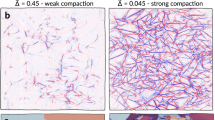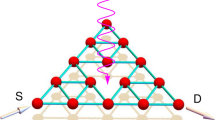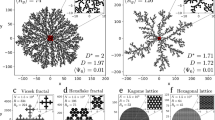Wavy leaves may not depend only on their genes to make their edges crinkle.
Abstract
The edge of a torn plastic sheet forms a complex three-dimensional fractal shape. We have found that the shape results from a simple elongation of the sheet in the direction along its edge. Natural growth processes in some leaves, flowers and vesicles could lead to a similar elongation and hence to the generation of characteristic wavy shapes.
Similar content being viewed by others
Main
We used rectangular plastic sheets pulled from the sides (in the y-direction) to generate a steadily travelling crack (in the x-direction). The high stresses near the crack tip produce an irreversible plastic deformation of the sheet and, as they are relieved, the deformed sheet is free to relax and to adopt a new shape in space.
Surprisingly, the equilibrium shape of the sheet consists of a cascade of waves upon waves along the newly formed edge. The waveform along the edge examined at six levels of magnification is self-similar, with a scaling factor of 3.2 (Fig. 1a). The amplitudes, A, of the waves in the cascades are simply related to their wavelengths λ by A = 0.15λ (Fig. 1b); the edge of the sheet is therefore a fractal. The fractal scaling spans 2.5 orders of magnitude and stops at a small length scale that is 6.5 times the sheet's thickness. Measurements of the deformation field revealed an increase in the length of the sheet in the x-direction that depends only on y, and decays smoothly to zero over a distance of a few millimetres from the edge (Fig. 1c).
a, Different magnifications of the edge of the sheet (0.012 mm thick). Successive pictures show the dotted boxed region on the left of the previous picture magnified by 3.2; the width of each image is indicated. b, The amplitude of a wave in the cascade is related to its wavelength by A = 0.15λ (solid line), for sheet thicknesses ranging from 0.012 to 0.5 mm. c, The length of a sheet (0.2 mm thick) in the x-direction, normalized by its original length, as a function of distance from the edge. Dashed line indicates the original length. d, Side (left) and front (right) views of a plastic sheet (top panels) and a beet leaf (bottom panels), showing the similarity between the two buckled sheets.
How can such featureless deformations lead to such complex shapes? The key to this is to realize that the bending rigidity of thin plates is much smaller than their stretching rigidity1. Thus, to reduce its elastic energy, the sheet can easily buckle into shapes that remove in-plane compression. The thinner the sheet and the larger the compression, the smaller are the possible wavelengths of the buckles. This principle is seen in action during the crumpling of paper sheets2,3,4,5 and the blistering of thin films6,7, where sheets adopt very complex shapes in response to a uniform external loading.
Unlike these examples, our sheets (after tearing is complete) are free and not subjected to any external loading. The spontaneous buckling occurs as a consequence of the stresses created by the differential deformation within the sheet. Far from the edge, the deformation is small (Fig. 1c), and the compression leads to buckling that has a single long wavelength. Closer to the edge, the compression increases rapidly, leading to an ordered buckling sequence with smaller and smaller wavelengths.
This phenomenon should be general, and indeed we found buckling cascades in numerical investigations of elastic sheets with deformations similar to those shown in Fig. 1c. Although in the experiment the sheet thinned near the edge (owing to volume conservation), the simulations both with and without thinning revealed buckling cascades. In addition, numerical analysis indicates that the particular scaling properties of the buckling depend on the deformation profile.
A similar increase in length near an edge, and therefore similar internal stresses, can result from growth processes. The wavy structures found in many flower petals, lichens and leaves, such as the beet leaf in Fig. 1d, might be formed in this way. No genetic coding is needed to instruct pieces of a leaf to curl up and curl down. All that is required is a growth process to elongate the sheet along its edge — elasticity takes care of the rest.
References
Lord Rayleigh Theory of Sound Vol. 1, 396 (Dover, New York, 1945).
Ben Amar, M. & Pomeau, Y. Proc. R. Soc. Lond. A 453, 729–755 (1997).
DiDonna, B. A., Witten, T. A., Venkataramani, S. C. & Kramer, E. M. Phys. Rev. E 65, 016603-1–016603-25 (2002).
Matan, K., Williams, R., Witten, T. & Nagel, S. Phys. Rev. Lett. 88, 076101-1–076101-4 (2002).
Kramer, E. & Witten, T. Phys. Rev. Lett. 78, 1303–1306 (1997).
Argon, A., Gupta, V., Landis, H. & Cornie, J. J. Mater. Sci. 24, 1207–1218 (1989).
Gioia, G. & Ortiz, M. Adv. Appl. Mech. 33, 119–192 (1997).
Author information
Authors and Affiliations
Corresponding author
Ethics declarations
Competing interests
The authors declare no competing financial interests.
Rights and permissions
About this article
Cite this article
Sharon, E., Roman, B., Marder, M. et al. Buckling cascades in free sheets. Nature 419, 579 (2002). https://doi.org/10.1038/419579a
Issue Date:
DOI: https://doi.org/10.1038/419579a
This article is cited by
-
Multistable sheets with rewritable patterns for switchable shape-morphing
Nature (2023)
-
Exact solutions for the wrinkle patterns of confined elastic shells
Nature Physics (2022)
-
Dimension reduction through gamma convergence for general prestrained thin elastic sheets
Calculus of Variations and Partial Differential Equations (2022)
-
Distributed Branch Points and the Shape of Elastic Surfaces with Constant Negative Curvature
Journal of Nonlinear Science (2021)
-
Selective Laser Pyrolytic Micropatterning of Stretched Elastomeric Polymer Surfaces
International Journal of Precision Engineering and Manufacturing-Green Technology (2021)
Comments
By submitting a comment you agree to abide by our Terms and Community Guidelines. If you find something abusive or that does not comply with our terms or guidelines please flag it as inappropriate.




